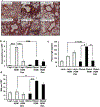Obesity shifts house dust mite-induced airway cellular infiltration from eosinophils to macrophages: effects of glucocorticoid treatment
- PMID: 26476732
- PMCID: PMC6035857
- DOI: 10.1007/s12026-015-8717-2
Obesity shifts house dust mite-induced airway cellular infiltration from eosinophils to macrophages: effects of glucocorticoid treatment
Abstract
Although classically characterized by chronic airway inflammation with eosinophil infiltration, asthma is a complex and multifactorial condition with numerous clinical phenotypes. Epidemiological studies strongly support the link between obesity and asthma and suggest that obesity precedes and promotes asthma development, increases asthma severity, and reduces steroid responsivity. Using a house dust mite (HDM) model of airway hyperresponsiveness in C57BL/6 mice, we examined the effects of diet-induced obesity on allergic airway inflammation and its treatment with dexamethasone. When compared to lean mice treated with HDM, obese-HDM mice had reduced plasma adiponectin, an anti-inflammatory adipokine, lower eosinophil and higher macrophage infiltration into the lungs and bronchoalveolar lavage (BAL) fluid, increased expression of total, M1, and M2 macrophage markers in the lungs, and enhanced Th2 and non-Th2 cytokine expression in the lungs. While Th2-associated responses in obese-HDM mice were suppressed by systemic dexamethasone, several Th2-independent responses, including total and M1 macrophage markers in the lungs, and lung CXC-motif ligand 1 (CXCL1) levels, were not improved following dexamethasone treatment. Thus, HDM combined with obesity promotes mixed localized inflammatory responses (e.g., M1, M2, Th1, and Th2) and shifts the cellular infiltration from eosinophils to macrophages, which are less sensitive to dexamethasone regulation. Because obese asthmatics exhibit more severe symptoms, lack a predominance of Th2 biomarkers, and are predicted to experience more steroid resistance when compared to lean asthmatics, this model could be used to study blunted steroid responses in obese-HDM mice and to define the macrophages found in the lungs.
Keywords: Airway inflammation; Asthma; Diet-induced obesity; Steroid resistance.
Figures








References
-
- Grant RW, Stephens JM: Fat in flames: Influence of cytokines and pattern recognition receptors on adipocyte lipolysis. Am J Physiol Endocrinol Metab 2015;ajpendo. - PubMed
-
- Agrawal A, Mabalirajan U, Ahmad T, Ghosh B: Emerging interface between metabolic syndrome and asthma. Am J Respir Cell Mol Biol 2011;44:270–275. - PubMed
-
- CDC Asthma Data and Surveillance. http://www.cdc.gov/asthma/asthmadata.htm . 2015. Ref Type: Electronic Citation
-
- Delgado J, Barranco P, Quirce S: Obesity and asthma. J Investig Allergol Clin Immunol 2008;18:420–425. - PubMed
Publication types
MeSH terms
Substances
Grants and funding
LinkOut - more resources
Full Text Sources
Other Literature Sources
Medical

